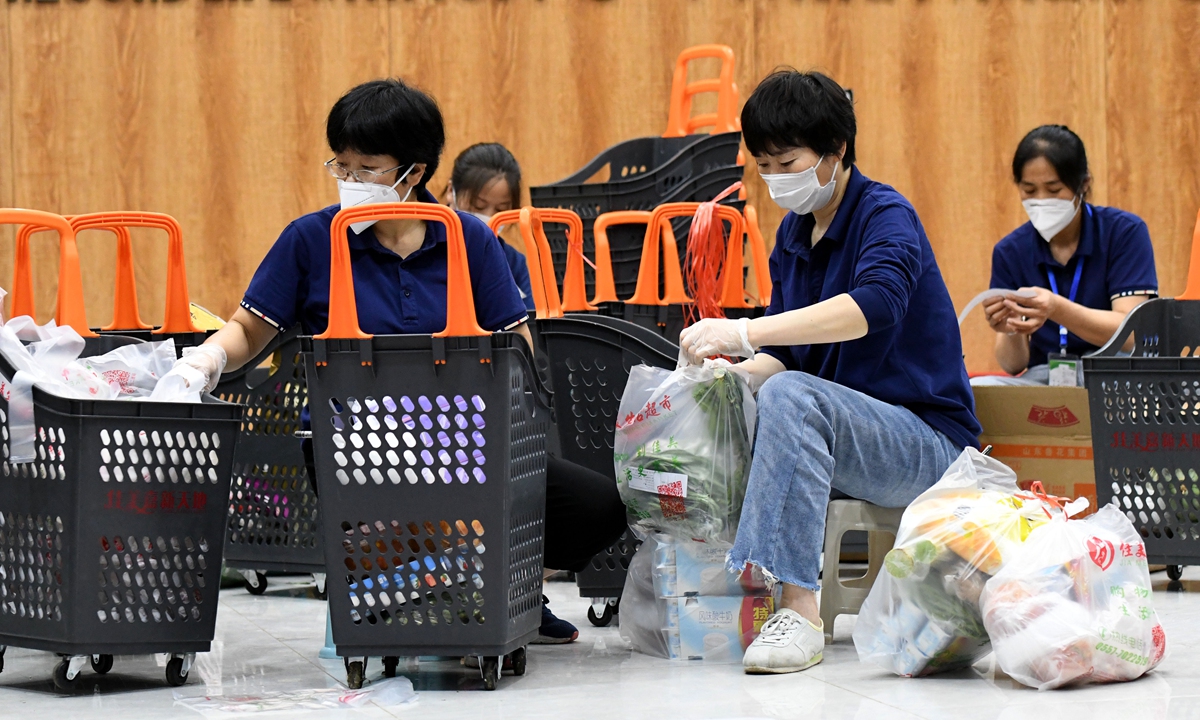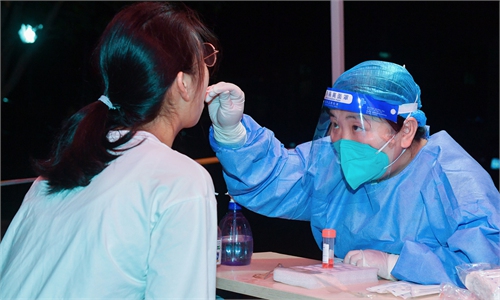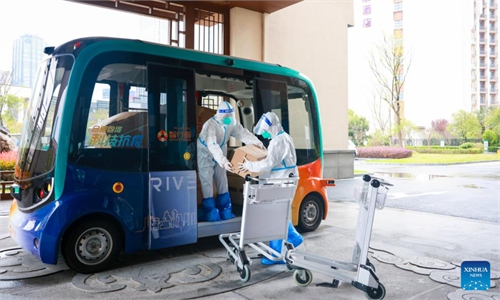Outbreak in Anhui county reveals anti-epidemic dilemma in rural areas
Education, training urged to enhance local capacity against virus

Local workers in Sixian county, East China's Anhui Province pack food supplies for online orders on July 4, 2022. Photo: Xinhua
While Chinese cities like Beijing and Shanghai have gradually built up a complete system to cope with the novel coronavirus, those at county level and rural areas, where medial resources are less abundant, are now faced with a severe test as shown in the latest outbreak in Sixian county in East China's Anhui Province.
Sixian reported 863 infections as of 4 pm Monday in the latest flare-up starting June 26, local authorities revealed on Monday.
The county announced a seventh round of mass nucleic acid testing on Monday. From June 26 to July 3, there were six rounds of mass nucleic acid involving over 3 million samples.
Anhui Province has reported 858 COVID-10 infections from June 26 to July 3 with most of the infections reported in Sixian county.
Located at a transportation junction in northeastern Anhui with a population of 700,000 and serving as a migrant labor provider to neighboring Jiangsu Province, the impact of the latest outbreak quickly expanded outside the county to other important locations in the Yangtze Delta regions such as Wuxi in Jiangsu and Yiwu in Zhejiang Province.
Wuxi has a population of 7.46 million, 10 times more than Sixian's.
According to Wuxi authorities, the city discovered seven COVID-19 infections on June 29. Two of the cases were migrant workers from Sixian and five others were their workmates or roommates.
The outbreak gained public attention, coming just as Beijing and Shanghai, which had been hit hard by the Omicron wave, declared they had detected no new cases and were easing up restrictions. The country also just shortened the centralized quarantine period for international arrivals and stopped marking cities with COVID infection risk areas in the travel tracking system last week.
A harsh reality demonstrated in the Sixian outbreak is that the experiences Beijing and Shanghai earned via bitter lessons cannot be easily transplanted and used in less developed regions that lack abundant medical resources, some experts said.
Residents in rural areas have weaker awareness of epidemic prevention. The virus is easy to spread in these areas when people gather and as labor migrates for work, Lu Hongzhou, head of the Third People's Hospital of Shenzhen, told the Global Times on Monday.
Poor medical conditions and the disperse distribution of inhabitation in rural areas also make it harder to conduct quick and efficient epidemiologist investigation, Lu noted.
Despite those difficulties, Lu tried to ease public concerns over anti-epidemic work in rural areas, calling for more education for local residents and training for local medical workers to cultivate a good habit of residents to accept the need for regular nucleic acid testing and reporting abnormal test results.
He suggested authorities in rural areas pay more attention to migrant laborers, especially those from places having reported infection cases.
Anhui has allocated all resources in the province to support Sixian's fight against the epidemic.
Under the coordination of the Anhui provincial authority, nucleic acid testing labs and vehicles from Bozhou and Chuzhou have come to Sixian to help, boosting local testing capacity to 171,000 samples per day.
About 22,320 rooms are being used for centralized quarantine in the county and another 11,471 standby rooms are ready. A total of 22,692 people related to the outbreak have been transferred to quarantine, media reported.
Anhui Party chief Zheng Shanjie inspected Sixian and vowed to mobilize all resources in the province to help Sixian win the fight against the virus.
Zheng ordered local authorities to secure local residents' demand for daily supplies and their need to see doctors.
Zheng called for quick reactions to eliminate community infections in one week and requires zero deaths due to the outbreak.
"The residents are not panicked over the epidemic, they care more about whether they can get daily supplies in a timely manner," a Sixian resident who used to work in a tourism company surnamed Zhou told the Global Times on Monday.
Before the recent outbreak, Wuxi announced on June 14 that it had established 15-minute nucleic acid testing circles for local residents to accept testing in accordance to their personal needs, instead of organizing mass nucleic acid testing.


